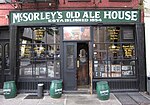Ninth Street station (IRT Third Avenue Line)
1878 establishments in New York (state)1955 disestablishments in New York (state)Defunct New York City Subway stations located abovegroundFormer elevated and subway stations in ManhattanIRT Third Avenue Line stations ... and 4 more
Manhattan railway station stubsRailway stations closed in 1955Railway stations in the United States opened in 1878Third Avenue

Ninth Street was an express station on the demolished IRT Third Avenue Line in Manhattan, New York City. It opened on August 26, 1878 and had two levels. The lower level was served by local trains and had two tracks and two side platforms. It was built first. The upper level was built as part of the Dual Contracts and had one track with two side platforms over the lower level local tracks which served express trains. This station closed on May 12, 1955, with the ending of all service on the Third Avenue El south of 149th Street.
Excerpt from the Wikipedia article Ninth Street station (IRT Third Avenue Line) (License: CC BY-SA 3.0, Authors, Images).Ninth Street station (IRT Third Avenue Line)
East 9th Street, New York Manhattan
Geographical coordinates (GPS) Address Nearby Places Show on map
Geographical coordinates (GPS)
| Latitude | Longitude |
|---|---|
| N 40.730027777778 ° | E -73.989444444444 ° |
Address
East 9th Street
East 9th Street
10003 New York, Manhattan
New York, United States
Open on Google Maps






